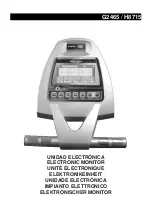
Section 6 — Effect Parameters
Edit/Effect Parameters
7
RELEASE TIME
Range:
1ms to 10.0s
This parameter determines the RELEASE TIME after the HOLD TIME has elapsed. Generally
this time is very short. Lower values offer an abrupt cutoff.
TRIGGER THRESHOLD
Range:
-96 to +0 dB
Set this parameter as low as possible to work with your particular sound source. To eliminate
false triggering, it should not be set too low. When the input signal rises above this threshold, the
reverse envelope will begin.
PRE-TRIGGER TIME
Range:
0 to 530 ms
This parameter is used to capture transients that occur before the trigger. This parameter is
critical to the sound quality. The user determines how much pretrigger sound will be injected
into the reverse reverb tank.
HF DAMPING
Range:
0 to 99
This parameter sounds best when set to low values. Its function is to filter out more and more
high frequency energy. For the most natural sounding reverse effect, we recommend a setting of
0.
DIFFUS1
Range:
0 to 99
DIFFUS1 smears the input signal making a smoother sounding reverb. This parameter controls
the high frequency ranges. For percussion sounds, high values are recommended.
DIFFUS2
Range:
0 to 99
Similar to and in series with DIFFUS1, this parameter controls lower frequency ranges.
DECAY DEFINITION
Range:
0 to 99
DECAY DEFINITION controls the rate at which echo density is increased with time. If set too
high, the echo density will build at a rate that exceeds the decay rate. This can be used for a
special effect.
MOD SRC 1
MOD SRC 2
DST 1
DST 2
MIN 1
MIN 2
MAX 1
MAX 2
These parameters are explained in detail in Section 5 — Effect Concepts.
ROM-21 GATED REVERB
GATED REVERB provides an excellent gated reverb. When a reverb is muted part way through, it
creates a gated sound. To achieve this gated effect, both the Gated and Reverse reverbs must gate a
number of internal parameters, not just the output amplitude envelope. It is however, the output
amplitude over which the user has control. The ASR-10 offers a highly controllable gated reverb,
optimized for percussive instruments, but useful for any input signal. The gate is first opened
when the input signal passes the trigger threshold. This trigger threshold is set as low as possible
by the user, so that none of the input signal is missed. The gated reverb is distinguished from the
reverse reverb by retriggering whenever the input signal passes a retrigger (user programmable)
threshold (see diagrams). The gate will stay open as long as the input signal remains above the
retrigger threshold, and all the input signals will be accumulated under this gate until the total
input signal level falls below the retrigger threshold. When this happens, the Hold Time will begin
(as shown in the diagram below). The reason there are two thresholds is to eliminate false
retriggering and to ensure precise hold time durations. If you desire a separate gate on each note,
use the Non Lin reverbs. The topology for the Gated Reverb is derived from the Plate Reverb. The
















































